The New York Times, whaa??? The New York Times chipped in on
Proposition 47 with some good sense. I hope as voters you'll remember to
vote for something that can help rather than hinder law enforcement.
This measure is supported by SOME veteran law enforcement professionals,
though the greater number of them oppose it.
A number of major
California newspapers that have endorsed a Yes vote on Prop 47. Then,
this morning, something unexpected happened.
The New York Times
editorial board, which rarely weighs in on California ballot
initiatives, added its voice to the chorus urging California voters to
pass this common sense reform. Our reform movement is catching fire
across California and across the country. Prop 47 could be on track to
become a model for other states.
Read the full editorial below, then forward this email to everyone you know in California.
Editorial: California Leads on Justice Reform
Prop 47 Could Take the State a Step Further in Reducing Overcrowding
For
a long time, the conventional political wisdom was that no one ever
lost an election for being too tough on crime. That wisdom has been
turned on its head in recent years, as both politicians and the public
are realizing how much damage the lock-’em-up mind-set has caused.
In
recent polls asking about the most important problems facing the
country, crime ranks way at the bottom. That’s because crime is at its
lowest levels in decades, even while overstuffed prisons cripple state
budgets.
A familiar retort is that crime is down precisely because the prisons are full, but that’s simply not true. Multiple studies show that crime has gone down faster in states that have reduced their prison populations.
An
encouraging example comes from California, the site of some the worst
excesses of the mass incarceration era, but also some of the more
innovative responses to it.
For five years, the state has been
under federal court order to reduce extreme overcrowding in its prisons.
In response, voters in 2012 overwhelmingly approved a ballot measure to
scale back the state’s notorious “three-strikes” law, leading to the
release, so far, of more than 1,900 prisoners who had been serving life
in prison — in some cases, for petty theft.
Dire warnings that
crime would go up as a result were unfounded. Over two years, the
recidivism rate of former three-strikes inmates is 3.4 percent, or less
than one-tenth of the state’s average. That’s, in large part, because of
a strong network of re-entry services.
The 2012 measure has
provided the model for an even bigger proposed release of prisoners that
California voters will consider on the ballot next week. Under
Proposition 47, many low-level drug and property offenses — like
shoplifting, writing bad checks or simple drug possession — would be
converted from felonies to misdemeanors.
That would cut an average
of about a year off the sentences of up to 10,000 inmates, potentially
saving the state hundreds of millions of dollars annually. To keep
people from returning to prison, or from going in the first place, the
savings would be invested in anti-truancy efforts and other programs
like mental health and drug-abuse treatment. Some would go to victims’
services, a perennially underfinanced part of the justice system.
Law-enforcement
officials, not surprisingly, oppose the measure, warning that crime
will go up. But they’ve already been proved wrong on three-strikes
reform.
Californians — who support the proposition by a
healthy margin, according to polls — have now seen for themselves that
they don’t have to choose between reducing prison populations and
protecting public safety.
It is very rare for lawmakers anywhere
to approve legislation to shorten sentences for people already in
prison; it is virtually unheard-of to do it by ballot measure.
California’s continuing experiment on sentencing can be a valuable
lesson to states around the country looking for smart and safe ways to
unravel America’s four-decade incarceration binge.
Think! Then vote. Hooray for Californians, leaders across the nation.
Friday, October 31, 2014
Thursday, October 30, 2014
PRIVATIZATION, SOCIALISM, BIG GOVERNMENT?
If you live under some weird illusion that the private sector is
good and your government is bad. Most likely – you have it wrong. Stop,
think about how the private sector runs to the government every time
they screw things up. Think about who funds the government – we do. Who
bails out big banks, big insurance, big Wall Street, big private sector
everything – we do. Who is getting short end of the straw? We are.
Example: “The Antares rocket supplied by contractor Orbital Sciences blew up moments after liftoff at NASA’s space launch facility on the Eastern Shore of Virginia, the space agency said:
“The explosion destroyed the rocket and spacecraft and immediately raised questions about the future of NASA’s reliance on private commercial ventures to carry vital payloads into space to supply and support the orbiting space station.”
This “private launch” cost us $200.000.000! It is the third such costly failure. How much
more of this nonsense should we allow before we wake up to the fact that we are being
used. PRIVATIZATION IS NOT WHAT HAS MADE THIS COUNTRY GREAT – WHAT HAS MADE AMERICA GREAT IS SOCIAL PROGRAMS THAT HAVE WORKED TO HELP BUILD A STRONG, WORKING MIDDLE CLASS, OUR EDUCATIONAL SYSTEM, AND THE AMERICAN WORKER – ALL ARE IN JEOPARDY.
This is how the private sector works: (St. Louis Post Dispatch) “The natural speculation is that UnitedHealthCare is hiding behind the ACA to boost its profits. In a letter to UnitedHealthCare CEO Stephen Hemsley (2010-2013 total compensation: $212 million) last spring, Thomas L. Holloway, executive vice president of the Missouri Medical Association, suggested the company is “cherry-picking … targeting the sickest, most costly patients and summarily terminating the physicians.”
What is really sad is during the last 20 years, the United States has finally socialized risk, but
privatized profit. Check out this link to read all about it:
http://www.huffingtonpost.com/david-feige/socializing-risk-privatiz_b_129281.html
Let’s think about ourselves on election day:
VOTE FOR AMERICA – VOTE FOR OUR CHILDREN – VOTE FOR YOURSELF – BUT VOTE
Yes, let’s take back our Government – (key words – let'”US” and “OUR”) Aren’t you tired of the few profiting from OUR tax dollars. How about taking a moment to remember when we had the “Greatest Generation” and how there was a growing and prosperous middle class. There was government and there was private sector jobs. There was socialization where it was needed. No merger wars and huge monopolies without regulations. It worked so well – shared prosperity. Mostly gone now – but still time to take it back.
STOP THE PRIVATIZATION OF OUR PUBLIC SCHOOLS – REELECT TOM TORLAKSON
GET CONTROL OF YOUR HEALTH INSURANCE PREMIUMS – YES ON PROP 45
NO ON PROP 46
REELECT DAVE JONES
-ELECT ART MOORE.
But, above all, don’t squander one of our most precious rights, get out and vote.
Example: “The Antares rocket supplied by contractor Orbital Sciences blew up moments after liftoff at NASA’s space launch facility on the Eastern Shore of Virginia, the space agency said:
“The explosion destroyed the rocket and spacecraft and immediately raised questions about the future of NASA’s reliance on private commercial ventures to carry vital payloads into space to supply and support the orbiting space station.”
This “private launch” cost us $200.000.000! It is the third such costly failure. How much
more of this nonsense should we allow before we wake up to the fact that we are being
used. PRIVATIZATION IS NOT WHAT HAS MADE THIS COUNTRY GREAT – WHAT HAS MADE AMERICA GREAT IS SOCIAL PROGRAMS THAT HAVE WORKED TO HELP BUILD A STRONG, WORKING MIDDLE CLASS, OUR EDUCATIONAL SYSTEM, AND THE AMERICAN WORKER – ALL ARE IN JEOPARDY.
This is how the private sector works: (St. Louis Post Dispatch) “The natural speculation is that UnitedHealthCare is hiding behind the ACA to boost its profits. In a letter to UnitedHealthCare CEO Stephen Hemsley (2010-2013 total compensation: $212 million) last spring, Thomas L. Holloway, executive vice president of the Missouri Medical Association, suggested the company is “cherry-picking … targeting the sickest, most costly patients and summarily terminating the physicians.”
What is really sad is during the last 20 years, the United States has finally socialized risk, but
privatized profit. Check out this link to read all about it:
http://www.huffingtonpost.com/david-feige/socializing-risk-privatiz_b_129281.html
Let’s think about ourselves on election day:
VOTE FOR AMERICA – VOTE FOR OUR CHILDREN – VOTE FOR YOURSELF – BUT VOTE
Yes, let’s take back our Government – (key words – let'”US” and “OUR”) Aren’t you tired of the few profiting from OUR tax dollars. How about taking a moment to remember when we had the “Greatest Generation” and how there was a growing and prosperous middle class. There was government and there was private sector jobs. There was socialization where it was needed. No merger wars and huge monopolies without regulations. It worked so well – shared prosperity. Mostly gone now – but still time to take it back.
STOP THE PRIVATIZATION OF OUR PUBLIC SCHOOLS – REELECT TOM TORLAKSON
GET CONTROL OF YOUR HEALTH INSURANCE PREMIUMS – YES ON PROP 45
NO ON PROP 46
REELECT DAVE JONES
-ELECT ART MOORE.
But, above all, don’t squander one of our most precious rights, get out and vote.
Labels:
privatization,
risk,
vote,
workers in jeopardy
Wednesday, October 29, 2014
NOBEL PRIZE WINNING ECONOMIST PAUL KRUGMAN.
The Nobel Prize-winning economist, once one of the president’s most notable critics, on why Obama is a historic success
And I wasn't wrong. Obama
was indeed naive: He faced scorched-earth Republican opposition from Day
One, and it took him years to start dealing with that opposition
realistically. Furthermore, he came perilously close to doing terrible
things to the U.S. safety net in pursuit of a budget Grand Bargain; we
were saved from significant cuts to Social Security and a rise in the
Medicare age only by Republican greed, the GOP's unwillingness to make
even token concessions.
But now the shoe is on
the other foot: Obama faces trash talk left, right and center –
literally – and doesn't deserve it. Despite bitter opposition, despite
having come close to self-inflicted disaster, Obama has emerged as one
of the most consequential and, yes, successful presidents in American
history. His health reform is imperfect but still a huge step forward –
and it's working better than anyone expected. Financial reform fell far
short of what should have happened, but it's much more effective than
you'd think. Economic management has been half-crippled by Republican
obstruction, but has nonetheless been much better than in other advanced
countries. And environmental policy is starting to look like it could
be a major legacy.
I'll go through those achievements
shortly. First, however, let's take a moment to talk about the current
wave of Obama-bashing. All Obama-bashing can be divided into three
types. One, a constant of his time in office, is the onslaught from the
right, which has never stopped portraying him as an Islamic atheist
Marxist Kenyan. Nothing has changed on that front, and nothing will.

Photo: Sean Gallup/Getty
There's
a different story on the left, where you now find a significant number
of critics decrying Obama as, to quote Cornel West, someone who ''posed
as a progressive and turned out to be counterfeit.'' They're outraged
that Wall Street hasn't been punished, that income inequality remains so
high, that ''neoliberal'' economic policies are still in place. All of
this seems to rest on the belief that if only Obama had put his
eloquence behind a radical economic agenda, he could somehow have gotten
that agenda past all the political barriers that have con- strained
even his much more modest efforts. It's hard to take such claims
seriously.
Finally, there's the constant belittling of
Obama from mainstream pundits and talking heads. Turn on cable news
(although I wouldn't advise it) and you'll hear endless talk about a
rudderless, stalled administration, maybe even about a failed
presidency. Such talk is often buttressed by polls showing that Obama
does, indeed, have an approval rating that is very low by historical
standards.
But this bashing is misguided even in its own terms – and in any case, it's focused on the wrong thing.
Yes,
Obama has a low approval rating compared with earlier presidents. But
there are a number of reasons to believe that presidential approval
doesn't mean the same thing that it used to: There is much more
party-sorting (in which Republicans never, ever have a good word for a
Democratic president, and vice versa), the public is negative on
politicians in general, and so on. Obviously the midterm election hasn't
happened yet, but in a year when Republicans have a huge structural
advantage – Democrats are defending a disproportionate number of Senate
seats in deep-red states – most analyses suggest that control of the
Senate is in doubt, with Democrats doing considerably better than they
were supposed to. This isn't what you'd expect to see if a failing
president were dragging his party down.
More important,
however, polls – or even elections – are not the measure of a
president. High office shouldn't be about putting points on the
electoral scoreboard, it should be about changing the country for the
better. Has Obama done that? Do his achievements look likely to endure?
The answer to both questions is yes.
HEALTH CARE
When Obama signed the Affordable Care Act, an excited Joe Biden whispered audibly, ''This is a big fucking deal!'' He was right.
The
enactment and implementation of the Affordable Care Act, a.k.a.
Obamacare, has been a perils-of-Pauline experience. When an upset in the
special election to replace Ted Kennedy cost Democrats their 60-vote
Senate majority, health reform had to be rescued with fancy legislative
footwork. Then it survived a Supreme Court challenge only thanks to a
surprise display of conscience by John Roberts, who nonetheless opened a
loophole that has allowed Republican-controlled states to deny coverage
to millions of Americans. Then technical difficulties with the
HealthCare.gov website seemed to threaten disaster. But here we are,
most of the way through the first full year of reform's implementation,
and it's working better than even the optimists expected.
We
won't have the full data on 2014 until next year's census report, but
multiple independent surveys show a sharp drop in the number of
Americans without health insurance, probably around 10 million, a number
certain to grow greatly over the next two years as more people realize
that the program is available and penalties for failure to sign up
increase.
It's true that the Affordable Care Act will
still leave millions of people in America uninsured. For one thing, it
was never intended to cover undocumented immigrants, who are counted in
standard measures of the uninsured. Furthermore, millions of low-income
Americans will slip into the loophole Roberts created: They were
supposed to be covered by a federally funded expansion of Medicaid, but
some states are blocking that expansion out of sheer spite. Finally,
unlike Social Security and Medicare, for which almost everyone is
automatically eligible, Obamacare requires beneficiaries to prove their
eligibility for Medicaid or choose and then pay for a subsidized private
plan. Inevitably, some people will fall through the cracks.
Still,
Obamacare means a huge improvement in the quality of life for tens of
millions of Americans – not just better care, but greater financial
security. And even those who were already insured have gained both
security and freedom, because they now have a guarantee of coverage if
they lose or change jobs.
What about the costs? Here,
too, the news is better than anyone expected. In 2014, premiums on the
insurance policies offered through the Obamacare exchanges were well
below those originally projected by the Congressional Budget Office, and
the available data indicates a mix of modest increases and actual
reductions for 2015 – which is very good in a sector where premiums
normally increase five percent or more each year. More broadly, overall
health spending has slowed substantially, with the cost-control features
of the ACA probably deserving some of the credit.
In
other words, health reform is looking like a major policy success story.
It's a program that is coming in ahead of schedule – and below budget –
costing less, and doing more to reduce overall health costs than even
its supporters predicted.
And some on the left were
outraged, arguing that the program would do more to raise profits in the
medical-industrial complex than it would to protect American families.
You
can still argue that single-payer would have covered more people at
lower cost – in fact, I would. But that option wasn't on the table; only
a system that appeased insurers and reassured the public that not too
much would change was politically feasible. And it's working reasonably
well: Competition among insurers who can no longer deny insurance to
those who need it most is turning out to be pretty effective. This isn't
the health care system you would have designed from scratch, or if you
could ignore special-interest politics, but it's doing the job.
And
this big improvement in American society is almost surely here to stay.
The conservative health care nightmare – the one that led Republicans
to go all-out against Bill Clinton's health plans in 1993 and Obamacare
more recently – is that once health care for everyone, or almost
everyone, has been put in place, it will be very hard to undo, because
too many voters would have a stake in the system. That's exactly what is
happening. Republicans are still going through the motions of attacking
Obamacare, but the passion is gone. They're even offering mealymouthed
assurances that people won't lose their new benefits. By the time Obama
leaves office, there will be tens of millions of Americans who have
benefited directly from health reform – and that will make it almost
impossible to reverse. Health reform has made America a different,
better place.
FINANCIAL REFORM
Let's
be clear: The financial crisis should have been followed by a drastic
crackdown on Wall Street abuses, and it wasn't. No important figures
have gone to jail; bad banks and other financial institutions, from
Citigroup to Goldman, were bailed out with few strings attached; and
there has been nothing like the wholesale restructuring and reining in
of finance that took place in the 1930s. Obama bears a considerable part
of the blame for this disappointing response. It was his Treasury
secretary and his attorney general who chose to treat finance with kid
gloves.
It's easy, however, to take this disappointment
too far. You often hear Dodd- Frank, the financial-reform bill that
Obama signed into law in 2010, dismissed as toothless and meaningless.
It isn't. It may not prevent the next financial crisis, but there's a
good chance that it will at least make future crises less severe and
easier to deal with.
Dodd-Frank is a complicated piece of legislation, but let me single out three really important sections.
First,
the law gives a special council the ability to designate ''systemically
important financial institutions'' (SIFIs) – that is, institutions that
could create a crisis if they were to fail – and place such
institutions under extra scrutiny and regulation of things like the
amount of capital they are required to maintain to cover possible
losses. During the 2012 presidential campaign, Mitt Romney claimed that
by announcing that some firms were SIFIs, the government was
effectively guaranteeing that they would be bailed out, which he called
''the biggest kiss that's been given to New York banks I've ever seen.''
But
it's easy to prove that this is nonsense: Just look at how institutions
behave when they're designated as SIFIs. Are they pleased, because
they're now guaranteed? Not a chance. Instead, they're furious over the
extra regulation, and in some cases fight bitterly to avoid being placed
on the list. Right now, for example, MetLife is making an all-out
effort to be kept off the SIFI list; this effort demonstrates that we're
talking about real regulation here, and that financial interests don't
like it.
Another key provision in Dodd-Frank is
''orderly liquidation authority,'' which gives the government the legal
right to seize complex financial institutions in a crisis. This is a
bigger deal than you might think. We have a well-established procedure
for seizing ordinary banks that get in trouble and putting them into
receivership; in fact, it happens all the time. But what do you do when
something like Citigroup is on the edge, and its failure might have
devastating consequences? Back in 2009, Joseph Stiglitz and yours truly,
among others, wanted to temporarily nationalize one or two major
financial players, for the same reasons the FDIC takes over failing
banks, to keep the institutions running but avoid bailing out
stockholders and management.
A third piece of
Dodd-Frank is the Consumer Financial Protection Bureau. That's Elizabeth
Warren's brainchild, an agency dedicated to protecting Americans
against the predatory lending that has pushed so many into financial
distress, and played an important role in the crisis. Warren's idea was
that such a stand-alone agency would more effectively protect the public
than agencies that were supposed to protect consumers, but saw their
main job as propping up banks. And by all accounts the new agency is in
fact doing much more to crack down on predatory practices than anything
we used to see.
There's much more in the financial
reform, there's enough evidence even now to say that there's a reason
Wall Street – which used to give an approximately equal share of money
to both parties but now overwhelmingly supports Republicans – tried so
hard to kill financial reform, and is still trying to emasculate
Dodd-Frank. This may not be the full overhaul of finance we should have
had, and it's not as major as health reform. But it's a lot better than
nothing.
THE ECONOMY
Barack
Obama might not have been elected president without the 2008 financial
crisis; he certainly wouldn't have had the House majority and the brief
filibuster-proof Senate majority that made health reform possible. So
it's very disappointing that six years into his presidency, the U.S.
economy is still a long way from being fully recovered.
Make
no mistake about it – the devastation wrought by the financial crisis
was terrible. Even in advanced countries, the median post-crisis
decline in per- capita real GDP is seven percent. Recovery has been
slow: It took almost six years for the United States to regain
pre-crisis average income. But that was actually a bit faster than the
historical average.
Or compare our performance with
that of the European Union. Unemployment in America rose to a horrifying
10 percent in 2009, but it has come down sharply in the past few years.
It's true that some of the apparent improvement probably reflects
discouraged workers dropping out, but there has been substantial real
progress. Meanwhile, Europe has had barely any job recovery at all, and
unemployment is still in double digits. Compared with our counterparts
across the Atlantic, we haven't done too badly.
Did
Obama's policies contribute to this less-awful performance? Yes, without
question. You'd never know it listening to the talking heads, but
there's overwhelming consensus among economists that the Obama stimulus
plan helped mitigate the worst of the slump. For
example, when a panel of economic experts was asked whether the U.S.
unemployment rate was lower at the end of 2010 than it would have been
without the stimulus, 82 percent said yes, only two percent said no.
Still,
couldn't the U.S. economy have done a lot better? Of course. The
original stimulus should have been both bigger and longer. And after Republicans won the House in 2010, U.S. policy took a sharp turn in the wrong direction. Not
only did the stimulus fade out, but sequestration led to further steep
cuts in federal spending, exactly the wrong thing to do in a
still-depressed economy.
We can argue about
how much Obama could have altered this literally depressing turn of
events. He could have pushed for a larger, more extended stimulus,
perhaps with provisions for extra aid that would have kicked in if
unemployment stayed high. (This isn't 20-20 hindsight, because a number
of economists, myself included, pleaded for more aggressive measures
from the beginning.) He arguably let Republicans blackmail him over the
debt ceiling in 2011, leading to the sequester. But this is all kind of
iffy.
The bottom line on Obama's economic policy should
be that what he did helped the economy, and that while enormous
economic and human damage has taken place on his watch, the United
States coped with the financial crisis better than most countries facing
comparable crises have managed. He should have done more and better,
but the narrative that portrays his policies as a simple failure is all
wrong.
While America remains an incredibly unequal
society, and we haven't seen anything like the New Deal's efforts to
narrow income gaps, Obama has done more to limit inequality than he gets credit for.
The rich are paying higher taxes, thanks to the partial expiration of
the Bush tax cuts and the special taxes on high incomes that help pay
for Obamacare; the Congressional Budget Office estimates the average tax
rate of the top one percent at 33.6 percent in 2013, up from 28.1
percent in 2008. Meanwhile, the financial aid in Obamacare – expanded
Medicaid, subsidies to help lower-income households pay insurance
premiums – goes disproportionately to less-well-off Americans. When
conservatives accuse Obama of redistributing income, they're not
completely wrong – and liberals should give him credit.
THE ENVIRONMENT
In
2009, it looked, briefly, as if we might be about to get real on the
issue of climate change. A fairly comprehensive bill establishing a
cap-and-trade system to limit greenhouse-gas emissions actually passed
the House, and visions of global action danced like sugarplums in
environmentalists' heads. But the legislation stalled in the Senate, and Republican victory in the 2010 midterms put an end to that fantasy.
Ever since, the only way forward has been through executive action
based on existing legislation, which is a poor substitute for the new
laws we need.
But as with financial reform, acknowledging the inadequacy of what has been done doesn't mean that nothing has been achieved. Saying
that Obama has been the best environmental president in a long time is
actually faint praise, since George W. Bush was terrible and Bill
Clinton didn't get much done. Still, it's true, and there's reason to
hope for a lot more over the next two years.

Photo: Doug Mills/The New York Times
First
of all, there has been much more progress on the use of renewable
energy than most people realize. The share of U.S. energy provided by
wind and solar has grown dramatically since Obama took office. True,
it's still only a small fraction of the total, and some of the growth in
renewables reflects technological progress, especially in solar panels,
that would have happened whoever was in office. But federal policies,
including loan guarantees and tax credits, have played an important
role.
Nor is it just about renewables; Obama has also
taken big steps on energy conservation, especially via fuel-efficiency
standards, that have flown, somewhat mysteriously, under the radar. And
it's not just cars. In 2011, the administration announced the first-ever
fuel-efficiency standards for medium and heavy vehicles, and in
February it announced that these standards would get even tougher for
models sold after 2018. As a way to curb green house-gas emissions,
these actions, taken together, are comparable in importance to proposed
action on power plants.
Which brings us to the latest initiative. Because
there's no chance of getting climate-change legislation through
Congress for the foreseeable future, Obama has turned to the EPA's
existing power to regulate pollution – power that the Supreme Court has
affirmed extends to emissions of carbon dioxide and other greenhouse
gases. And this past summer, the EPA announced proposed rules
that would require a large reduction over time in such emissions from
power plants. You might say that such plants are only a piece of the
problem, but they're a large piece – CO2 from
coal-burning power plants is in fact a big part of the problem, so if
the EPA goes through with anything like the proposed rule, it will be a
major step. Again, not nearly enough, and we'll have to do a lot more
soon, or face civilization-threatening disaster. But what Obama has done is far from trivial.
NATIONAL SECURITY
So
far, i've been talking about Obama's positive achievements, which have
been much bigger than his critics understand. I do, however, need to
address one area that has left some early Obama supporters bitterly
disappointed: his record on national security policy. Let's face it –
many of his original enthusiasts favored him so strongly over Hillary
Clinton because she supported the Iraq War and he didn't. They hoped he
would hold the people who took us to war on false pretenses accountable,
that he would transform American foreign policy, and that he would
drastically curb the reach of the national security state.
None
of that happened. Obama's team, as far as we can tell, never even
considered going after the deceptions that took us to Baghdad, perhaps
because they believed that this would play very badly at a time of
financial crisis. On overall foreign policy, Obama has been
essentially a normal post-Vietnam president, reluctant to commit U.S.
ground troops and eager to extract them from ongoing commitments, but
quite willing to bomb people considered threatening to U.S. interests.
And he has defended the prerogatives of the NSA and the surveillance
state in general.
Could and should he have
been different? The truth is that I have no special expertise here; as
an ordinary concerned citizen, I worry about the precedent of allowing
what amount to war crimes to go not just unpunished but uninvestigated,
even while appreciating that a modern version of the 1970s Church
committee hearings on CIA abuses might well have been a political
disaster, and undermined the policy achievements I've tried to
highlight. What I would say is that even if Obama is just an
ordinary president on national security issues, that's a huge
improvement over what came before and what we would have had if John
McCain or Mitt Romney had won. It's hard to get excited about a policy of not going to war gratuitously, but it's a big deal compared with the alternative.
SOCIAL CHANGE
In
2004, social issues, along with national security, were cudgels the
right used to bludgeon liberals – I like to say that Bush won
re-election by posing as America's defender against gay married
terrorists. Ten years later, and the scene is transformed: Democrats
have turned these social issues – especially women's rights – against
Republicans; gay marriage has been widely legalized with approval or at
least indifference from the wider public. We have, in a remarkably short
stretch of time, become a notably more tolerant, open-minded nation.
As
you can see, there's a theme running through each of the areas of
domestic policy I've covered. In each case, Obama delivered less than
his supporters wanted, less than the country arguably deserved, but more
than his current detractors acknowledge. The extent of his partial
success ranges from the pretty good to the not-so-bad to the ugly.
Health reform looks pretty good, especially in historical perspective –
remember, even Social Security, in its original FDR version, only
covered around half the workforce. Financial reform is, I'd argue, not
so bad – it's not the second coming of Glass-Steagall, but there's a lot
more protection against runaway finance than anyone except angry Wall
Streeters seems to realize. Economic policy wasn't enough to avoid a
very ugly period of high unemployment, but Obama did at least mitigate
the worst.
And as far as climate policy goes, there's reason for hope, but we'll have to see.
Am
I damning with faint praise? Not at all. This is what a successful
presidency looks like. No president gets to do everything his supporters
expected him to. FDR left behind a reformed nation, but one in which
the wealthy retained a lot of power and privilege. On the other side,
for all his anti-government rhetoric, Reagan left the core institutions
of the New Deal and the Great Society in place. I don't care about the
fact that Obama hasn't lived up to the golden dreams of 2008, and I care
even less about his approval rating. I do care that he has, when all is
said and done, achieved a lot. That is, as Joe Biden didn't quite say, a
big deal.
I co-opted this from an interview of Krugman by Rolling Stones Magazine, and shortened it somewhat without changing meaning.
Monday, October 27, 2014
RE-BLOGGING WHISTLEBLOWERS.
I’m grateful for the whistleblowers who have provided us with transparency and exposed illegal practices by employers or by the government. California, New Jersey, and New York have friendly whistleblower laws. I read where some states have made it against the law to report abuses in their states, but I couldn’t find it on the net-yet.
Whistleblower Who Exposed White House Tampering with Climate Science Dies
By Paul Thacker
Rick Piltz passed away
last Saturday. He spent decades working in the federal government and
state government in Texas, and was a prominent whistleblower during the
Bush administration. He later founded Climate Science Watch.
I first met Rick Piltz after reading a 2005 New York Times story exposing a concerted effort by the Bush White House to down play links between greenhouse gas emissions and climate change. The story was a blockbuster and featured leaked documents with the actual handwritten edits of White House officials. I eventually figured out the leaker was Rick Piltz.
I was working for a science journal and called to ask if he would do a Q&A with us. At that time, I was beginning to realize that the White House was trying to bury and deny scientific evidence that harmed corporate products or was at cross purposes to Republican party ideology. This effort extended to EPA chemical regulations and FDA approval of birth control. That’s why I wanted to interview Piltz. I wanted the view of a veteran government expert to explain to scientists how scientific policy really happens. Not the theory, but the actual practice.

We met at a bar close to the White House in the late afternoon. I wanted a casual discussion in a relaxed environment so I could get him to be as honest as possible. I figured hanging out at a bar over a couple of beers would be best. This was his first time speaking up since he had left the government.
Piltz was nervous and stressed during the interview. He had just left a secure job, because he could no longer take what was happening in the U.S. Global Change Research Program, the federal group created to help the nation address global warming. He didn’t know what he was going to do next in his career.
The main White House perpetrator, he told me, was Philip Cooney, a former employee at the American Petroleum Institute, who the White House had hired to coordinate the nation’s reports on climate change. Within days of the New York Times article, Cooney resigned from the White House and was then hired by Exxon Mobil, a company that had a long track record of disseminating disinformation on climate change.
During our talk, Piltz made it clear that the White House was doing everything possible to create confusion on climate change. “With all these arcane debates about climate models and cost–benefit economic models, the general public can’t get their arms around climate change,” he said. What the administration didn’t want was for people to start learning about what was going to happen in their communities: how climate change was going to affect grain farmers in the Midwest, people living on the Gulf Coast, and New Yorkers dealing with a subway system that could get flooded by storm surge.
When you stop discussing arcane scientific algorithms, he said, you create a national discussion. “[Y]ou start talking about real things that affect people.”
What Piltz said nine years ago has come into sharper focus. The year after Piltz went public, hurricane Katrina hit the Gulf Coast and devastated New Orleans. Some scientists say it was made more powerful by climate change. In a moment of recent irony, the Secretary of Energy visited Houston, Texas, to warn locals that the city’s petroleum infrastructure—including the Ship Channel and refineries—are vulnerable to climate change. The politics have also evolved. Corn growers in Iowa are worried now that global warming will harm agriculture and formed a political action committee to oppose a politician who denies climate change. Piltz was even right about hurricanes affecting Manhattan subways, something that I thought was absurd at the time. After hurricane Sandy wracked New York City, Lloyds of London stated that the storm surge from sea level rise caused 30 percent of the economic loss. That’s $8 billion in New York alone.

Piltz later founded Climate Science Watch, a program with the Government Accountability Project. He didn’t want another government job, he told me, because he was tired of working for other people and moving their agenda forward. It was time for him to go it alone.
Exposing how the White House was manipulating government reports on climate change spurred congressional investigations and coverage by 60 Minutes and several documentaries. The issue of scientific integrity became so acute that one of President Obama’s first directives after he was elected concerned restoring integrity to the scientific process.
Unlike many in the environmental community, Piltz did not quickly jump on the Obama bandwagon. He knew that the problems dealing with scientific integrity was ingrained in both parties, and he never yielded from criticizing the new President.
Created in part by financially conflicted think tanks and their academic compatriots, a new meme has emerged: scientists who speak out are no longer scientists; they are “activists.” The point is to discredit a scientist who does not sit quietly on the sidelines, publishing research in academic journals that most citizens will never read. Nowhere is this more rampant than in climate science, an area where experts with incredible math skills find their research torn apart by attorneys who probably couldn’t pass a course in differential equations at a local community college.
I honestly have no clue what this term “activist” means. If my doctor, for instance, tells me to eat better or risk cardiovascular disease, I would listen and try and make dietary changes. I wouldn’t think that, by giving medical advice, my doctor was a crusader against cattle ranchers and the potato chip companies.
Piltz spent decades in science policy and had a clear understanding of how science can get distorted, buried and misused if it inconveniences people in power.
“Scientists see politics as beneath them,” he said. “So they don’t learn how to engage policy makers. You can’t just drop some journal article over the transom and hope for the best.”
The danger for scientific experts isn’t just in speaking up. The danger is also remaining silent.
Rick wasn’t afraid to speak up. He will be missed.
I first met Rick Piltz after reading a 2005 New York Times story exposing a concerted effort by the Bush White House to down play links between greenhouse gas emissions and climate change. The story was a blockbuster and featured leaked documents with the actual handwritten edits of White House officials. I eventually figured out the leaker was Rick Piltz.
I was working for a science journal and called to ask if he would do a Q&A with us. At that time, I was beginning to realize that the White House was trying to bury and deny scientific evidence that harmed corporate products or was at cross purposes to Republican party ideology. This effort extended to EPA chemical regulations and FDA approval of birth control. That’s why I wanted to interview Piltz. I wanted the view of a veteran government expert to explain to scientists how scientific policy really happens. Not the theory, but the actual practice.
We met at a bar close to the White House in the late afternoon. I wanted a casual discussion in a relaxed environment so I could get him to be as honest as possible. I figured hanging out at a bar over a couple of beers would be best. This was his first time speaking up since he had left the government.
Piltz was nervous and stressed during the interview. He had just left a secure job, because he could no longer take what was happening in the U.S. Global Change Research Program, the federal group created to help the nation address global warming. He didn’t know what he was going to do next in his career.
The main White House perpetrator, he told me, was Philip Cooney, a former employee at the American Petroleum Institute, who the White House had hired to coordinate the nation’s reports on climate change. Within days of the New York Times article, Cooney resigned from the White House and was then hired by Exxon Mobil, a company that had a long track record of disseminating disinformation on climate change.
During our talk, Piltz made it clear that the White House was doing everything possible to create confusion on climate change. “With all these arcane debates about climate models and cost–benefit economic models, the general public can’t get their arms around climate change,” he said. What the administration didn’t want was for people to start learning about what was going to happen in their communities: how climate change was going to affect grain farmers in the Midwest, people living on the Gulf Coast, and New Yorkers dealing with a subway system that could get flooded by storm surge.
When you stop discussing arcane scientific algorithms, he said, you create a national discussion. “[Y]ou start talking about real things that affect people.”
What Piltz said nine years ago has come into sharper focus. The year after Piltz went public, hurricane Katrina hit the Gulf Coast and devastated New Orleans. Some scientists say it was made more powerful by climate change. In a moment of recent irony, the Secretary of Energy visited Houston, Texas, to warn locals that the city’s petroleum infrastructure—including the Ship Channel and refineries—are vulnerable to climate change. The politics have also evolved. Corn growers in Iowa are worried now that global warming will harm agriculture and formed a political action committee to oppose a politician who denies climate change. Piltz was even right about hurricanes affecting Manhattan subways, something that I thought was absurd at the time. After hurricane Sandy wracked New York City, Lloyds of London stated that the storm surge from sea level rise caused 30 percent of the economic loss. That’s $8 billion in New York alone.
Piltz later founded Climate Science Watch, a program with the Government Accountability Project. He didn’t want another government job, he told me, because he was tired of working for other people and moving their agenda forward. It was time for him to go it alone.
Exposing how the White House was manipulating government reports on climate change spurred congressional investigations and coverage by 60 Minutes and several documentaries. The issue of scientific integrity became so acute that one of President Obama’s first directives after he was elected concerned restoring integrity to the scientific process.
Unlike many in the environmental community, Piltz did not quickly jump on the Obama bandwagon. He knew that the problems dealing with scientific integrity was ingrained in both parties, and he never yielded from criticizing the new President.
Created in part by financially conflicted think tanks and their academic compatriots, a new meme has emerged: scientists who speak out are no longer scientists; they are “activists.” The point is to discredit a scientist who does not sit quietly on the sidelines, publishing research in academic journals that most citizens will never read. Nowhere is this more rampant than in climate science, an area where experts with incredible math skills find their research torn apart by attorneys who probably couldn’t pass a course in differential equations at a local community college.
I honestly have no clue what this term “activist” means. If my doctor, for instance, tells me to eat better or risk cardiovascular disease, I would listen and try and make dietary changes. I wouldn’t think that, by giving medical advice, my doctor was a crusader against cattle ranchers and the potato chip companies.
Piltz spent decades in science policy and had a clear understanding of how science can get distorted, buried and misused if it inconveniences people in power.
“Scientists see politics as beneath them,” he said. “So they don’t learn how to engage policy makers. You can’t just drop some journal article over the transom and hope for the best.”
The danger for scientific experts isn’t just in speaking up. The danger is also remaining silent.
Rick wasn’t afraid to speak up. He will be missed.
Sunday, October 26, 2014
NO PRIVILEGED SCHOOLS IN CALIFORNIA, PLEASE.
THIS ARTICLE IS REPRINTED FROM FORBES MAGAZINE, A CONSERVATIVE MAGAZINE WHOSE EDITORS AND WRITERS KNOW THE MONEY GAME.
"Charter School Gravy Train Runs Express To Fat City"
By Addison Wiggin
"Too bad the kids in charter schools don’t learn any better than those in plain-vanilla public schools. Stanford University crunched test data from 26 states. About a quarter of charters delivered better reading scores, but more than half produced no improvement, and 19% had worse results. In math, 29% of the charters delivered better math scores, while 40% showed no difference, and 31% fared worse."
PLEASE - JUST READ THIS BEFORE YOUR VOTE
http://www.forbes.com/sites/greatspeculations/2013/09/10/charter-school-gravy-train-runs-express-to-fat-city/
http://www.washingtonpost.com/blogs/answer-sheet/wp/2013/09/17/is-the-charter-school-gravy-train-running-express-to-fat-city/
"In Florida, the for-profit school industry flooded legislative candidates with $1.8 million in donations last year."
Nor does the evidence show that charters spend taxpayers’ money more efficiently. Researchers from Michigan State and the University of Utah studied charters in Michigan, finding they spent $774 more per student on administration, and $1,140 less on instruction.
STOP! DO NOT VOTE FOR SCHOOL PRIVATIZATION!!
Dear Friends -
Why would any person vote for school vouchers and the corporate take over of our schools by Wall Street bankers? History is rapidly showing us that charter schools are harming our children by taking our education tax dollars and giving them to a small group of greedy "investors." So by voting for Marshal Tuck, you are indeed voting to give our children's education financing to billionaire investment bankers and hedge fund operators.
For months now I have been trying to tell you the truth - but I am worried that you do not want to take time to learn what is true. So please, take five minutes, read the very conservative Forbes Magazine article that tells it like it is. THEN VOTE FOR TOM TORLAKSON and help him continue to help our students.
Yes, education in California has sucked for 30 years now - we just let it go. It is our fault, California has dropped to 35th in per student spending. Spending is easy to determine, whereas performance can be influenced by many different factors and factions. Our children in California do not rate good, but not bad either. By looking at several different rating organizations, we rank in the "30's" out of 51. Or as one rating group put it, we get a C+. I can remember when I was growing up in the 50's and 60's, we were said to be number 1.
The good news is - we are again getting better.
"Charter School Gravy Train Runs Express To Fat City"
By Addison Wiggin
"Too bad the kids in charter schools don’t learn any better than those in plain-vanilla public schools. Stanford University crunched test data from 26 states. About a quarter of charters delivered better reading scores, but more than half produced no improvement, and 19% had worse results. In math, 29% of the charters delivered better math scores, while 40% showed no difference, and 31% fared worse."
PLEASE - JUST READ THIS BEFORE YOUR VOTE
http://www.forbes.com/sites/greatspeculations/2013/09/10/charter-school-gravy-train-runs-express-to-fat-city/
http://www.washingtonpost.com/blogs/answer-sheet/wp/2013/09/17/is-the-charter-school-gravy-train-running-express-to-fat-city/
"In Florida, the for-profit school industry flooded legislative candidates with $1.8 million in donations last year."
Nor does the evidence show that charters spend taxpayers’ money more efficiently. Researchers from Michigan State and the University of Utah studied charters in Michigan, finding they spent $774 more per student on administration, and $1,140 less on instruction.
STOP! DO NOT VOTE FOR SCHOOL PRIVATIZATION!!
Dear Friends -
Why would any person vote for school vouchers and the corporate take over of our schools by Wall Street bankers? History is rapidly showing us that charter schools are harming our children by taking our education tax dollars and giving them to a small group of greedy "investors." So by voting for Marshal Tuck, you are indeed voting to give our children's education financing to billionaire investment bankers and hedge fund operators.
For months now I have been trying to tell you the truth - but I am worried that you do not want to take time to learn what is true. So please, take five minutes, read the very conservative Forbes Magazine article that tells it like it is. THEN VOTE FOR TOM TORLAKSON and help him continue to help our students.
Yes, education in California has sucked for 30 years now - we just let it go. It is our fault, California has dropped to 35th in per student spending. Spending is easy to determine, whereas performance can be influenced by many different factors and factions. Our children in California do not rate good, but not bad either. By looking at several different rating organizations, we rank in the "30's" out of 51. Or as one rating group put it, we get a C+. I can remember when I was growing up in the 50's and 60's, we were said to be number 1.
The good news is - we are again getting better.
Saturday, October 25, 2014
GETTING THERE IS HALF THE BATTLE.
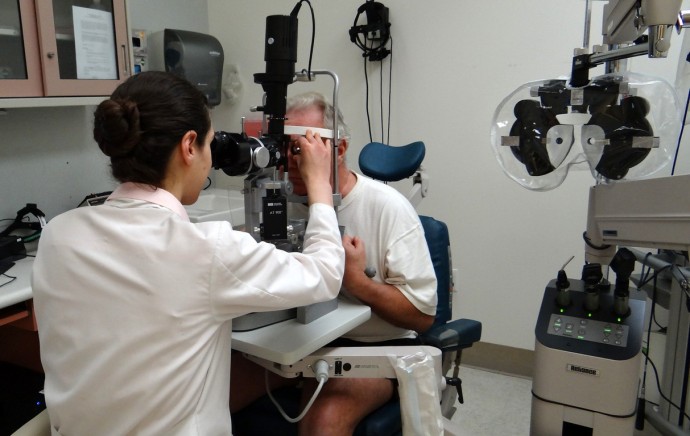
Thursday, we went to the Palo Alto Veterans Hospital for Jim’s post-op exam on his right eye and a pre-op exam and scheduling for his left eye surgery. It was our third 141 mile trip (one-way) to the hospital and we finally figured the best way of getting there. With the hospital’s cooperation we were able to leave at 9:30 and miss the horrendous morning traffic, spend the night, get up for early appointments, and leave mid-day and avoid the end of day work traffic. What a difference that made.
I managed to get in about 3 hours of reading and tootled around the hospital and took pictures of artwork and talked to people. We met Bobby Brown, the “muffler man”, again, and spent the dinner hour with him. He is a very interesting guy; chock full of life’s stories.
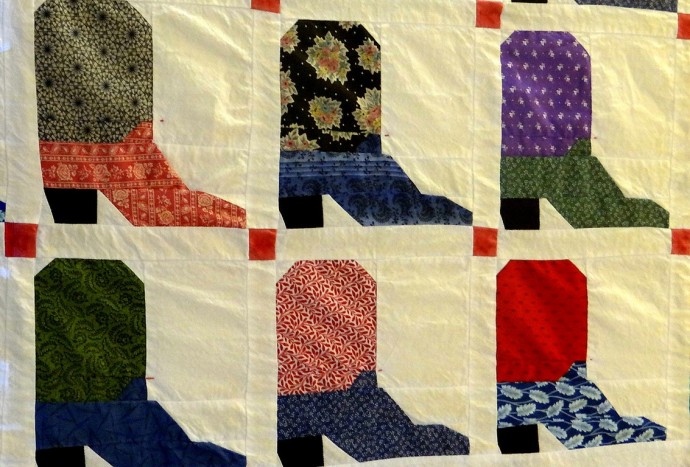
Artwork and collections take away the antiseptic appearance of the hospital. This boot quilt pattern is always a fun one to do.

Children’s bonnets from an Asian country, colorful and bright and cheerful. Much needed elements in a hospital.
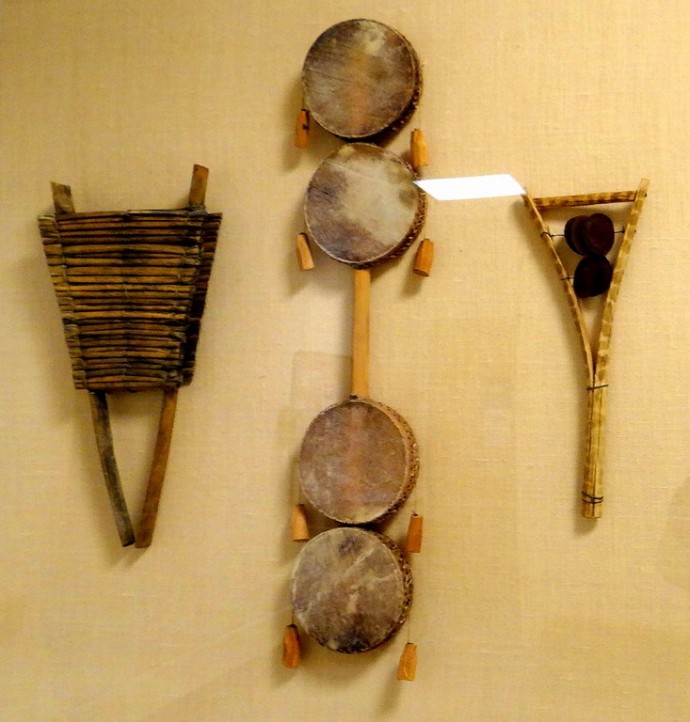
Small musical instruments.

In one office, I talked to a worker who collects little mouse objects.

They were really cute. Working people spend most of their day on the job. Personalizing workspace is an accepted practice everywhere you go these days. I hail that practice.
On the way home, we stopped at the Golden Corral Restaurant in Tracy where Jim and I met six years ago. The food got better since our first visit, I’m glad to report.
Back to Murphys and my endless tasks. I’ve been talking about going to Australia and today, I’m going to seriously look at some tours.
Thursday, October 23, 2014
TOMORROW, TOMORROW, THERE'S ALWAYS TOMORROW.
This morning, I bring Karen to the hospital for her surgery
early in the morning. Then take Jim to his post-op appointment at Palo
Alto Veterans Hospital. Karen's friend Tom will pick her up and bring
her home.
Jim and I return tomorrow. I've been diligently watering and packing stuff off to my storage unit. Fall is definitely here with nights getting down to 43 and 44 degrees. But, no rain in the forecast.
I have a new internet service called Uverse. It is supposed to be much faster than DSL. I don't think it is super fast, but the data you can transfer is huge and it does play video's which my old system often could or would not.
It seems all we do is TALK about the weather and wish it were better. I got this Weather Trivia in an email from Ron Heinsma and I don't know its origin. Hope you find it amusing.
Weather Trivia.
Jim and I return tomorrow. I've been diligently watering and packing stuff off to my storage unit. Fall is definitely here with nights getting down to 43 and 44 degrees. But, no rain in the forecast.
I have a new internet service called Uverse. It is supposed to be much faster than DSL. I don't think it is super fast, but the data you can transfer is huge and it does play video's which my old system often could or would not.
It seems all we do is TALK about the weather and wish it were better. I got this Weather Trivia in an email from Ron Heinsma and I don't know its origin. Hope you find it amusing.
Weather Trivia.
| 10 cities with Least weather variety Based on temperature variation, precipitation, wind, severe weather |
|
| Top 10 hail prone cities Based on frequency and severity of hail |
|
| Top 10 Tropical storm / Hurricane prone cities Average # of years with no storm. Totals based on data from 1871- 2007, hitting within 60 miles of the city | |
| 2.49 |
| 2.54 |
| 2.58 |
| 2.58 |
| 2.58 |
| 2.63 |
| 2.63 |
| 2.69 |
| 2.69 |
| 2.69 |
| Top 10 Tornado states Avg number of tornadoes per 10,000 square Miles, occurring from 1953-2004 | |
| 9.4 |
| 8.2 |
| 6.7 |
| 6.6 |
| 6.2 |
| 6.1 |
| 5.7 |
| 5.7 |
| 5.6 |
| 5.2 |
| Top 10 Thunderstorm Cities Avg annual number of thunderstorms | |
| 89 |
| 87 |
| 83 |
| 81 |
| 80 |
| 79 |
| 79 |
| 76 |
| 75 |
| 75 |
| Top 10 Tornado prone cities Ranked by tornadoes per 1,000 miles |
|
| Top 10 Earthquake prone states # of earthquakes in the last 30 years Centered in the state |
|
| 10 all-time hottest Temperatures Obtained from state temperature Records, NCDC | |
| 134 |
| 128 |
| 125 |
| 122 |
| 121 |
| 121 |
| 120 |
| 120 |
| 120 |
| 120 |
| 10 all-time coldest Temperatures Obtained from state temperature Records, NCDC | |
| -80 |
| -70 |
| -69 |
| -66 |
| -61 |
| -60 |
| -60 |
| -60 |
| -58 |
| -55 |
| 10 hottest cities Average annual temperature, F | |
| 77.7 |
| 75.6 |
| 74.6 |
| 73.9 |
| 73.9 |
| 73.6 |
| 72.4 |
| 72.4 |
| 72.1 |
| 72.0 |
| 10 coldest cities Average annual temperature, F | |
| 36.4 |
| 38.2 |
| 38.9 |
| 39.2 |
| 39.7 |
| 40.5 |
| 40.8 |
| 41.2 |
| 41.3 |
| 41.4 |
| 10 driest cities Avg annual precipitation in inches | |
| 2.65 |
| 4.19 |
| 5.61 |
| 5.72 |
| 7.11 |
| 7.13 |
| 7.49 |
| 7.64 |
| 7.82 |
| 7.82 |
| 10 wettest cities Avg annual precipitation in inches | |
| 128.00 |
| 104.50 |
| 69.60 |
| 67.87 |
| 64.64 |
| 64.59 |
| 61.16 |
| 59.74 |
| 59.72 |
| 59.55 |
| 10 snowiest cities Avg annual precipitation in inches | |
| 240.8 |
| 128.6 |
| 116.7 |
| 111.6 |
| 110.4 |
| 104.9 |
| 102.5 |
| 99.9 |
| 97.8 |
| 97.0 |
| 10 windiest cities Avg annual wind speed in mph | |
| 15.4 |
| 14.0 |
| 13.5 |
| 13.1 |
| 12.9 |
| 12.9 |
| 12.7 |
| 12.6 |
| 12.5 |
| 12.4 |
| 10 sunniest cities Annual percent of possible sunshine | |
| 90% |
| 85% |
| 85% |
| 85% |
| 83% |
| 79% |
| 79% |
| 79% |
| 78% |
| by Earl Tupper.NEW JERSEY .................. Has the most shopping malls in one area in the world.NEW MEXICO ............... Smokey the Bear was rescued from a 1950 forest fire here. NEW YORK .................... Is home to the nation's oldest cattle ranch, started in 1747 in Montauk. NORTH CAROLINA ........ Home of the first Krispy Kreme doughnut. NORTH DAKOTA ............ Rigby , North Dakota , is the exact geographic center of North America .. OHIO ............................. The hot dog was invented here in 1900. OKLAHOMA ................... The grounds of the state capital are covered by operating oil wells. OREGON ......................... Has the most ghost towns in the country. PENNSYLVANIA ............. The smiley : ) was first used in 1980 by computer scientists at Carnegie Mellon University .. RHODE ISLAND ............. The nation's oldest bar, the White Horse Tavern, opened here in 1673. SOUTH CAROLINA ......... Sumter County is home to the world's largest gingko farm. SOUTH DAKOTA ............. Is the only state that's never had an earthquake. TENNESSEE ....................... Nashville 's Grand Ole Opry is the longest running live radio show in the world. TEXAS ............................... Dr. Pepper was invented in Waco in 1885. The hamburger was invented in Arlington in 1906. UTAH ................................. The first Kentucky Fried Chicken restaurant opened here in 1952. VERMONT ........................ Montpelier is the only state capital without a McDonald's. VIRGINIA ........................... Home of the world's largest office building, The Pentagon. WASHINGTON .................. Seattle has twice as many college graduates as any other state. WASHINGTON D.C. ......... Is the first planned capital in the world. WEST VIRGINIA .................. Had the world's first brick paved street, Summers Street, laid in Charleston in 1870. WISCONSIN ...................... The ice cream sundae was invented here in 1881 to get around Blue Laws prohibiting ice cream from being sold on Sundays. WYOMING ........................ Was the first state to allow women to vote. I hope you enjoyed this. I found it interesting!!! | |
Wednesday, October 22, 2014
ALLIGATOR HUNTING.

With a signal so weak, I couldn’t finish a blog on Monday. I turned my Prius in for repair, FINALLY. It was another full day devoted to getting my car fixed after the accident of June 12th. I fought to have my Prius fixed instead of totaled, and after a long process, fraught with hang-ups, (as in the body shopped scheduled to fix it went out of business,) it was delivered to the capable hands of C&C Body Shop in Sonora. While there, we had to wait to pick up a rental car, a silver KIA that fits in my garage.
We went out to lunch in Sonora and when I got home I didn’t feel like cooking. We decided to veg in front of the television with some food and turned on a program called Swamp People. It was an old program series that played from 6:00 to 9:00 and most of it was about Cajun alligator hunters. Having visited that part of the country, having met a couple of alligator hunters, the memories flowed. Those were really exciting times. We ate a lot of alligator meat in Southern Louisiana, mostly sausage, but we were never part of a hunt. After watching the Swamp People, I felt like I went alligator hunting.
I got so excited, I had to replay my alligator pictures. A different camera, no editing done, so I selected a few pics from the album.
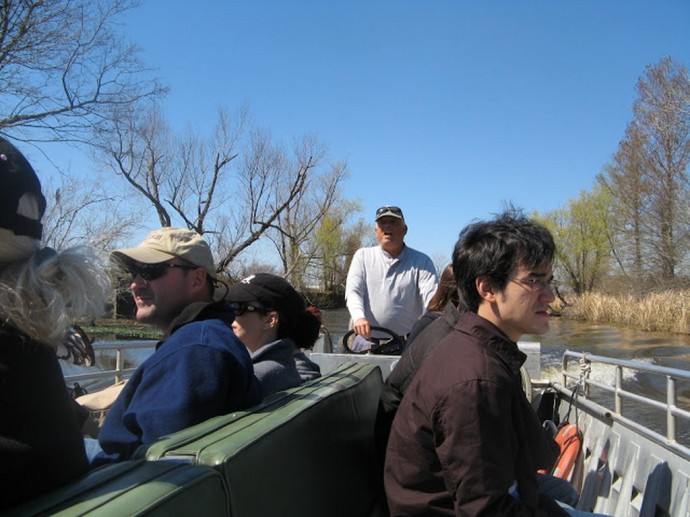
We took an alligator sighting tour boat into the swamps. The boats in the program and this one are flat bottomed affairs, built by Cajuns for alligator hunting.

We spotted this big one.

It was unafraid and the boat didn’t get too close.
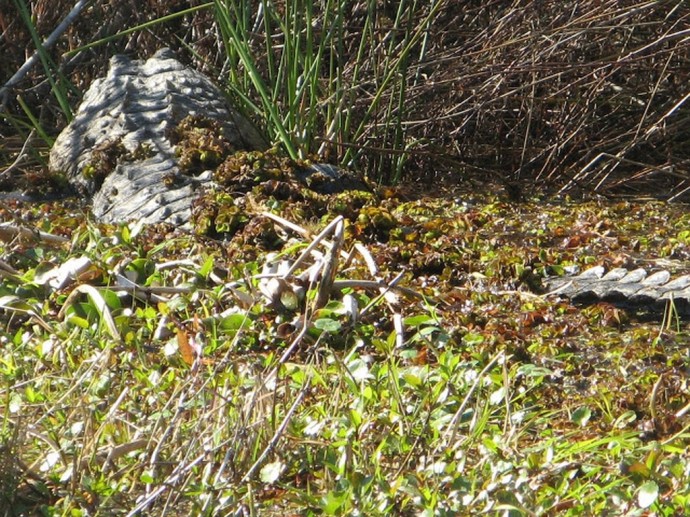
Then we saw this big bull, the guide called him. The broad head is a giveaway.

I got a second shot of this big bull. I took two shots of small gators buried deep in the shallow swamp grasses, but I had to look three times at my own photos to pick them out. They were well camouflaged, so I didn’t download the pictures. Alligators are fearless and fast. Basically the king predator of the swamps. Their only enemy is man.
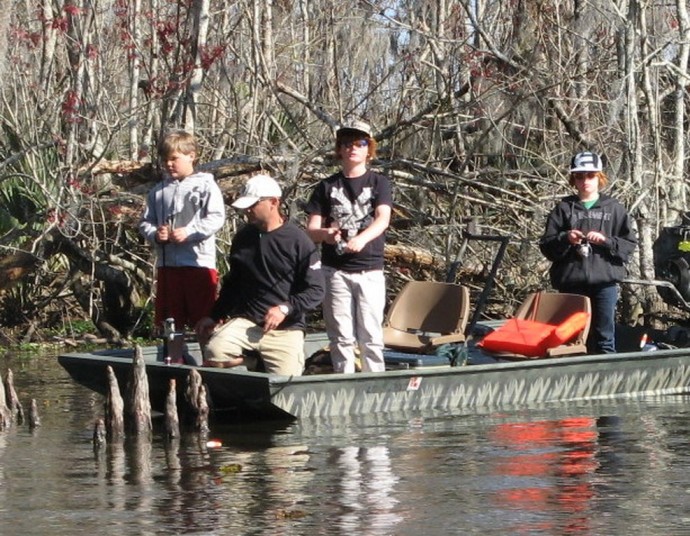
This is a better picture of the type of flat boats the hunters use, though the sides are a bit steeper. This group is fishing for something, but not alligators.
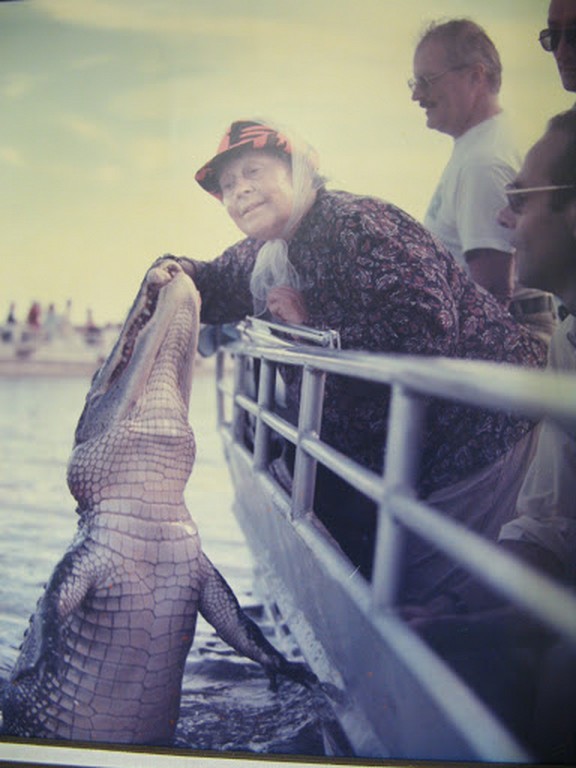
A picture of a picture of “Mary," feeding an alligator to demonstrate to the tour what they look like. She owned the company at one time. It is too dangerous to “chum” alligators and the company quit the practice. The picture didn’t say if this event was at an alligator farm or in the wild. Alligator skin is more valuable than the meat.

Near Little Chenier, we met a real alligator hunter who goes by the name of Dirty Miller. We were looking for the town of Little Chenier, or remnants of it. It was destroyed by Hurricane Rita. Up against a choice, where the pavement ended, a gravel road in front of us, without knowing where it came out, we stopped. We turned around in Miller’s driveway and he hollered at us to “com’on, dinner will be ready in a half an hour.” Miller is the epitome of Southern hospitality and a real character.
Wiped out by Katrina, Miller built a large shed on the spot where his house once stood. It was flooded by Rita and he showed us the water line on the walls of his shed. In that pot was a big stew and we joined him and his friends for a Sunday afternoon dinner and listened raptly to alligator hunting stories and many other tales. He had pictures of Donald Trump and some other notables, (I no longer remember the names,) people he took alligator hunting. We ended up spending the night. Dirty Miller and his girl friend cooked us a giant omelet for breakfast the next morning with shrimp, crawfish, crab and alligator sausage. One of our favorite, memorable stops in Louisiana.

This is a picture of a picture of Dirty Miller’s grandson sitting on a gator he killed. I’m savoring the memories again through my pictures. My only regret is that I didn’t take more pictures of this fascinating guy and his friends.
Sunday, October 19, 2014
ANGELS CAMP GOLD RUSH FAIR.

It was a good decision to take a day off and attend the Angels Camp Gold Rush Fair. It was the first time for me. Town was full and people were having a good time.

In the Chamber Of Commerce/Visitors Center parking area was a food court, a band and a few set-ups of what living in the gold rush era was like, with barrels and sacks and a reference to Henry Angel for whom the camp was, and now the town is named.

You didn't have to go camping, because life was lived in a "camp". During Angels Camp's 75th anniversary of the incorporation of the town, Mayor Betsy Alford managed to find descendents of Henry Angel and invited them to participate, and several of them came to celebrate.

Operating in the lot, a modern gold washer demonstrating how gold rich gravels are sucked up onto riffles that allow heavy gold to sink to the bottom of the washer and the rest of the rock and dirt flows back into the stream. This one has a powerful motor. The old-timers didn't have that advantage. Their "sluice boxes" were propped in the river and bottom gravel was hand shoveled onto the riffles. It was cold, wet, hard work.

I didn't ask, but I think these folks were selling covered wagon rides. A beautiful team, in any event.

The townspeople are encouraged to dress in rustic clothing and many did.

.

These buck skinned dudes and their ladies are part of a staged gunfight they have on the street, which we missed and left before their next one.

I admired this dude's fox skin cap. What a beautiful cap but I did feel sorry the fox had to give its life for it.

Maria Behn is an excellent Patsy Cline impersonator and we enjoyed listening to her sing. Her husband is a vet and they live in the county near San Andreas.

A young juggler kept the crowd mesmerized with his various feats. Looking at everyone's faces while he tossed those knives around was as much fun as his patter. He quipped: "Look at me, I graduated from Bret Harte High School and I'm doing fine."

He could cut apples. Not only cut them, but bite them while juggling three knives. He finished the apple/knife bit with a flourish, stabbing one. He was fun.

Jim quipped to this girl, "Aah, a real genuine red-head," knowing that she wasn't, to which she answered, "and I was a real genuine blonde yesterday."
We had a great bowl of chili for lunch. The fair is an annual event they've put on for about 4 or 5 years. I like meeting old friends I haven't seen in a long time, and I did see some locals I knew, but Gary and Denise Lindsay, who are old friends from the Sheriff's Department days, surprised me. They've retired to Sonora area, in Tuolumne County, and love the Mother Lode and came over to enjoy the festivities.
Labels:
buck skins,
chili,
covered wagon,
goldrush,
gun fights
Saturday, October 18, 2014
GULF COAST BIRDS.
The passenger pigeon of yesterday reminded me of some of the
beautiful birds I've seen and had the opportunity to photograph. Here is
an album from the Texas gulf coast.
These pictures are copyrighted, 2013, Mary Matzek
 |
| 2013-Gulf Coast Birds |
Friday, October 17, 2014
SAVORING WHAT WE HAVE LEFT.
Business and society thrive by investing in nature. I have Pax World
Mutual Funds and their newsletter editor declared that human caused
climate change is real. They busted the myths about climate change quite
soundly. Whether our representatives and senators want to believe it
or deny it and fail to deal with climate change, corporations are
preparing for the changes ahead. And Pax is adjusting their portfolios
to include major corporations who are preparing for climate change NOW. I
was so pleased to hear that.
September 1st, 2014 is designated as the 100 year mark when the last passenger pigeon died-a species that once numbered in the billions. It is the first acknowledged human caused extinction. To draw attention to how serious extinctions are, Andy Stern, a neurologist and activist has begun a project called fold the flock. They have a pattern for an origami passenger pigeon that you can fold. There are a number of different ways they will display them around the country. I'm going to do it, one for each of my grandsons.
http://foldtheflock.org/
We need to take climate change and extinctions seriously consider that there are only seven living white Rhinoceros in the Ol Pejeta conservancy in Kenya.
In 2013 fifty-nine regular rhinos were killed for their horns and 302 elephants for their tusks. Their herds are now down to hundreds and extinction is likely in our lifetimes unless something dramatic changes.
With better co-operation between government and native populations, by making it profitable for natives to protect elephants and rhinos, this year, only 3 rhinos were killed and they are heavily guarded to the point were guards are corralling and sleeping with them.
We are all diminished by these extinctions. Please be an activist and do what you can to save our endangered species where and when you can. Subscribe to one of the magazines or environmental groups, like The Nature Conservancy, National Geographic, Smithsonian, Scientific American, African Wildlife Conservation, Natural Resources Defense council, (NRDC), Environmental Defense Fund, Living Oceans... There are hundreds of hardworking non-profit groups fighting the battle. Let's help so our children and grandchildren can savor what we have left.
September 1st, 2014 is designated as the 100 year mark when the last passenger pigeon died-a species that once numbered in the billions. It is the first acknowledged human caused extinction. To draw attention to how serious extinctions are, Andy Stern, a neurologist and activist has begun a project called fold the flock. They have a pattern for an origami passenger pigeon that you can fold. There are a number of different ways they will display them around the country. I'm going to do it, one for each of my grandsons.
http://foldtheflock.org/
We need to take climate change and extinctions seriously consider that there are only seven living white Rhinoceros in the Ol Pejeta conservancy in Kenya.
In 2013 fifty-nine regular rhinos were killed for their horns and 302 elephants for their tusks. Their herds are now down to hundreds and extinction is likely in our lifetimes unless something dramatic changes.
With better co-operation between government and native populations, by making it profitable for natives to protect elephants and rhinos, this year, only 3 rhinos were killed and they are heavily guarded to the point were guards are corralling and sleeping with them.
We are all diminished by these extinctions. Please be an activist and do what you can to save our endangered species where and when you can. Subscribe to one of the magazines or environmental groups, like The Nature Conservancy, National Geographic, Smithsonian, Scientific American, African Wildlife Conservation, Natural Resources Defense council, (NRDC), Environmental Defense Fund, Living Oceans... There are hundreds of hardworking non-profit groups fighting the battle. Let's help so our children and grandchildren can savor what we have left.
Thursday, October 16, 2014
SIGNAL PROBLEMS.
Changing phone service after 34 years is an iffy proposition. I
don’t recommend it. There are disadvantages to rural living and phone,
internet, television and cell service is inadequate at times. Even our
M.Home signal is so slow right now I cannot get in my email.
Hope we have better options tomorrow at the library. My new phone service allows me to test it for 30 days. If not satisfied, I have a few other options.
So, call me.
Hope we have better options tomorrow at the library. My new phone service allows me to test it for 30 days. If not satisfied, I have a few other options.
So, call me.
Wednesday, October 15, 2014
CAR DAMAGE FIXED.
My car will go in for it's three week repair session on Monday. YAY! I
did more running around on errands, I needed oyster shell, some nesting
hay, dump, some other errands before I'm without it.
Then slept in this morning, so, I'm sending myself and anyone who needs it a bouquet of flowers.
Then slept in this morning, so, I'm sending myself and anyone who needs it a bouquet of flowers.
 |
| 2012-4-28-GbyFlrs |
Tuesday, October 14, 2014
BEGGING POLITICIANS OUT IN FORCE.
It is that time of year when politicians are out in force begging for
money to keep themselves elected. That money keeps the television and
radio stations richer than rich, our elected officials remain greedy,
powerful and corrupt, and nothing much changes in government. What a
sham. Read columnist Charlie Reese's take on the situation from a few
years back. As true today as then.
545 vs. 300,000,000 People
-By Charlie Reese
Politicians are the only people in the world who create problems and then campaign against them.
Have you ever wondered, if both the Democrats and the Republicans are against deficits, WHY do we have deficits?
Have you ever wondered, if all the politicians are against inflation and high taxes, WHY do we have inflation and high taxes?
You and I don't propose a federal budget. The President does.
You and I don't have the Constitutional authority to vote on appropriations.
The House of Representatives does.
You and I don't write the tax code, Congress does.
You and I don't set fiscal policy, Congress does.
You and I don't control monetary policy, the Federal Reserve Bank does.
One hundred senators, 435 congressmen, one President, and nine Supreme Court justices equates to 545 human beings out of the 300 million are directly, legally, morally, and individually responsible for the domestic problems that plague this country.
I excluded the members of the Federal Reserve Board because that problem was created by the Congress. In 1913, Congress delegated its Constitutional duty to provide a sound currency to a federally chartered, but private, central bank.
I excluded all the special interests and lobbyists for a sound reason. They have no legal authority. They have no ability to coerce a senator, a congressman, or a President to do one cotton-picking thing. I don't care if they offer a politician $1 million dollars in cash. The politician has the power to accept or reject it. No matter what the lobbyist promises, it is the legislator's responsibility to determine how he votes.
Those 545 human beings spend much of their energy convincing you that what they did is not their fault. They cooperate in this common con regardless of party.What separates a politician from a normal human being is an excessive amount of gall. No normal human being would have the gall of a Speaker, who stood up and criticized the President for creating deficits.
The President can only propose a budget. He cannot force the Congress to accept it.
The Constitution, which is the supreme law of the land, gives sole responsibility to the House of Representatives for originating and approving appropriations and taxes. Who is the speaker of the House?
John Boehner. He is the leader of the majority party. He and fellow House members, not the President, can approve any budget they want. If the President vetoes it, they can pass over his veto if they agree to.
It seems inconceivable to me that a nation of 300 million cannot replace 545 people who stand convicted -- by present facts -- of incompetence and irresponsibility. I can't think of a single domestic problem that is not traceable directly to those 545 people. When you fully grasp the plain truth that 545 people exercise the power of the federal government, then it must follow that what exists is what they want to exist.
If the tax code is unfair, it's because they want it unfair.
If the budget is in the red, it's because they want it in the red.
If the Army & Marines are in Iraq and Afghanistan it's because they want them in Iraq and Afghanistan ...
If they do not receive social security but are on an elite retirement plan not available to the people, it's because they want it that way.
There are no insoluble government problems.
Do not let these 545 people shift the blame to bureaucrats, whom they hire and whose jobs they can abolish; to lobbyists, whose gifts and advice they can reject; to regulators, to whom they give the power to regulate and from whom they can take this power. Above all, do not let them con you into the belief that there exists disembodied mystical forces like "the economy," "inflation," or "politics" that prevent them from doing what they take an oath to do.
Those 545 people, and they alone, are responsible.
They, and they alone, have the power.
They, and they alone, should be held accountable by the people who are their bosses.
Provided the voters have the gumption to manage their own employees...
We should vote all of them out of office and clean up their mess!
Charlie Reese is a former columnist of the Orlando Sentinel Newspaper.
If everyone of us printed this article out and sent it to every senator and representative in our districts, it might wake them up. But, don't bet the rent.
545 vs. 300,000,000 People
-By Charlie Reese
Politicians are the only people in the world who create problems and then campaign against them.
Have you ever wondered, if both the Democrats and the Republicans are against deficits, WHY do we have deficits?
Have you ever wondered, if all the politicians are against inflation and high taxes, WHY do we have inflation and high taxes?
You and I don't propose a federal budget. The President does.
You and I don't have the Constitutional authority to vote on appropriations.
The House of Representatives does.
You and I don't write the tax code, Congress does.
You and I don't set fiscal policy, Congress does.
You and I don't control monetary policy, the Federal Reserve Bank does.
One hundred senators, 435 congressmen, one President, and nine Supreme Court justices equates to 545 human beings out of the 300 million are directly, legally, morally, and individually responsible for the domestic problems that plague this country.
I excluded the members of the Federal Reserve Board because that problem was created by the Congress. In 1913, Congress delegated its Constitutional duty to provide a sound currency to a federally chartered, but private, central bank.
I excluded all the special interests and lobbyists for a sound reason. They have no legal authority. They have no ability to coerce a senator, a congressman, or a President to do one cotton-picking thing. I don't care if they offer a politician $1 million dollars in cash. The politician has the power to accept or reject it. No matter what the lobbyist promises, it is the legislator's responsibility to determine how he votes.
Those 545 human beings spend much of their energy convincing you that what they did is not their fault. They cooperate in this common con regardless of party.What separates a politician from a normal human being is an excessive amount of gall. No normal human being would have the gall of a Speaker, who stood up and criticized the President for creating deficits.
The President can only propose a budget. He cannot force the Congress to accept it.
The Constitution, which is the supreme law of the land, gives sole responsibility to the House of Representatives for originating and approving appropriations and taxes. Who is the speaker of the House?
John Boehner. He is the leader of the majority party. He and fellow House members, not the President, can approve any budget they want. If the President vetoes it, they can pass over his veto if they agree to.
It seems inconceivable to me that a nation of 300 million cannot replace 545 people who stand convicted -- by present facts -- of incompetence and irresponsibility. I can't think of a single domestic problem that is not traceable directly to those 545 people. When you fully grasp the plain truth that 545 people exercise the power of the federal government, then it must follow that what exists is what they want to exist.
If the tax code is unfair, it's because they want it unfair.
If the budget is in the red, it's because they want it in the red.
If the Army & Marines are in Iraq and Afghanistan it's because they want them in Iraq and Afghanistan ...
If they do not receive social security but are on an elite retirement plan not available to the people, it's because they want it that way.
There are no insoluble government problems.
Do not let these 545 people shift the blame to bureaucrats, whom they hire and whose jobs they can abolish; to lobbyists, whose gifts and advice they can reject; to regulators, to whom they give the power to regulate and from whom they can take this power. Above all, do not let them con you into the belief that there exists disembodied mystical forces like "the economy," "inflation," or "politics" that prevent them from doing what they take an oath to do.
Those 545 people, and they alone, are responsible.
They, and they alone, have the power.
They, and they alone, should be held accountable by the people who are their bosses.
Provided the voters have the gumption to manage their own employees...
We should vote all of them out of office and clean up their mess!
Charlie Reese is a former columnist of the Orlando Sentinel Newspaper.
If everyone of us printed this article out and sent it to every senator and representative in our districts, it might wake them up. But, don't bet the rent.
Labels:
begging,
corruption,
greed,
money,
politicians,
poor,
power,
representatives,
rich,
senators
Monday, October 13, 2014
VETERANS HOSPITAL ART FIX.

I'm very comforted by the fact that public places like airports, hospitals and other great buildings share with us some of the great art of the world. If you can't get your art fix in a gallery, you can freely walk around public buildings and enjoy. This glass sculpture hangs from the ceiling at the Defenders Lodge at the Palo Alto Veterans Hospital. It hangs down into the stair well from the 3rd story above. It is considered a mobile and reminds me of Dale Chihuly's work. No one knew if it was one of his installations or not.
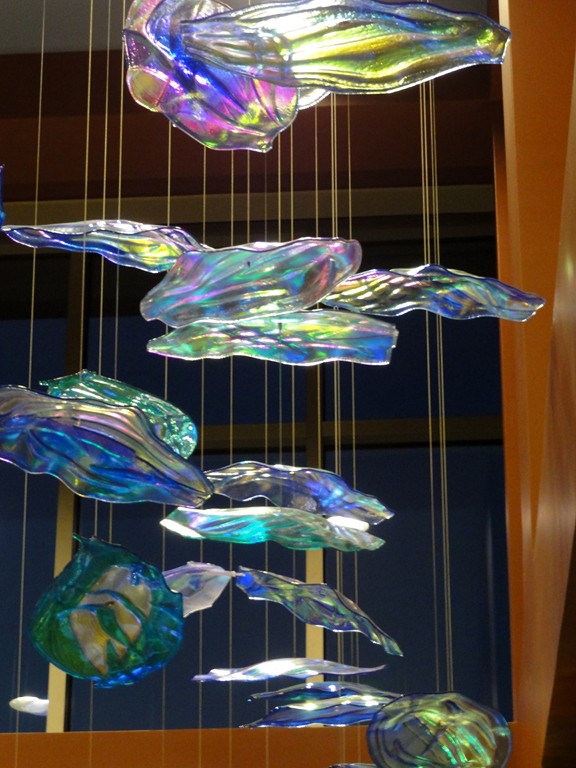
The pieces resemble butterflies, or stingrays.

Such beauty. In this area, the glass pieces created colored shadows on the wall.

Most of the "leaves" are a foot long or more. I always say, pictures don't do it justice, and it is true.

The lighting makes them luminous. Photographing them from the stairwell is easy.

The Defenders Lodge has a terrific library, with comfortable chairs and many books. It has closed doors and is a very quiet contemplative place. This bowl of glass balls sits on a desk.

On a coffee table, some ceramic flat work.

They encourage you to say, "Gee, I could do that!" Of course, I didn't, and someone else did. And, they look easy until you start to build one. I like them. I worked with clay a bit at one point in my "wanna be an artist" former life.

In the radiology clinic, about 20 or more paintings were horse themed. All of them are behind glass and because of the glare, getting a decent picture was tough.

I tried, after admiring these horses racing through the snow.

And splashing through water.

A wood print, also under glass.

There are stunning pieces in this collection, but like this one, the glare is impossible. But, I thought seeing the people reflected in the background gave it some merit.

Doll figures were in a different hall. When Jim has his eye done the next time, I'm going to use my waiting time by visiting each floor and each clinic and admire the art work that is sure to be there.
In closing, we met and talked with Bobby Brown and another vet, Ron (last name long Italian) Batt, for short. He was born and raised in San Francisco, went to the same High School as my husband, who was also born and raised in S.F. They traveled some of the same by-ways and told similar stories about similar watering holes and restaurants. Ron was great fun, a good story-teller and it turned out that we had mutual friends in Tom and Mary Kingshill, who moved from S.F. to Murphys about 18 years ago. It was a fun reminisce.
Now I have to consider showers and toilets, wall plugs, lighting fixtures, refrigerator placement...that kind of stuff, but a worthy task.
Subscribe to:
Posts (Atom)


